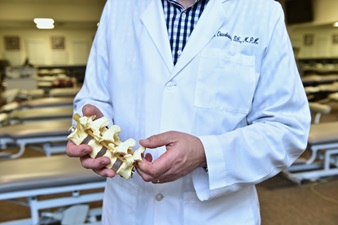About the College of Chiropractic
Mission Statement
The College of Chiropractic prepares doctors of chiropractic as leaders for the delivery and advancement of natural and holistic approaches to patient-centered health care through excellence in education, professional and scholarly activity, clinical service, and community engagement.

Curriculum Organization
The Doctor of Chiropractic curriculum is organized in seven academic and clinical departments. The sequence provides a strong foundational science basis upon which the chiropractic and clinical sciences are built. As clinical subjects are introduced, students make the transition to becoming doctors of chiropractic. In the classroom, laboratory, and clinics, students learn to take patient health histories and conduct examinations (including clinical, orthopedic, neurologic, laboratory, and imaging examinations) and interpret findings in forming clinical decisions, leading to a diagnosis. Students learn that proper diagnosis is fundamental in determining appropriate treatment and in measuring the patient’s response to chiropractic care.
Department of Chiropractic Foundational Sciences
The Department of Foundational Sciences' mission is to establish an evidence-informed framework of fundamental knowledge in human health and wellness, biomechanics, and disease. This framework empowers students to effectively apply this knowledge and critical thinking skills within clinical environments. Subjects include biochemistry, anatomy, embryology, histology, immunology, microbiology, neuroscience, pathology, physiology and evidence informed practice. These sciences are essential to the development of an understanding of the complexities of the structural basis of health and disease, as well as the nature of the functioning of the human body in health and disease.
Department of Chiropractic Studies
The Department of Chiropractic Studies covers content in philosophy, technique and physiological therapeutics. Courses in chiropractic principles and philosophy provide students with the history of the chiropractic profession, as well as the nature of the chiropractic health care model and its principal tenets. Chiropractic methods courses and labs begin in trimester one and progress through trimester seven setting the stage for the life-long journey to becoming a master in the art of chiropractic adjustment and manipulation. Three physiological therapeutics courses further prepare students to perform orthopedic evaluations and provide exercise, rehabilitation, and passive modalities as part of the patient care plan.
Department of Clinical Sciences
The process of arriving at a diagnosis involves cognitive, behavioral, and affective skills that are acquired over a period of time and sharpened with clinical experiences. These courses are delivered over a five-trimester period and include a variety of learning experiences, such as lecture, small-group, experiential laboratories, self-directed study, and online learning. The courses include Clinical Skills 1 and 2 (which prepare students to obtain a medical history and perform a physical examination), clinical pathology, and a number of specialized system-based courses which cover the diagnosis and chiropractic role in the management of a variety of health problems.
Department of Health Promotion and Associated Clinical Sciences
The health promotion and wellness course sequence is designed to provide students with the knowledge and skills necessary to apply chiropractic care to special populations and includes courses covering the unique aspects of diagnosis and treatment of pregnant patients, infants and children, women, and the elderly. Courses in this department also cover the topics of public health, health promotion, and wellness, especially as these apply to the practice of chiropractic.
Department of Diagnostic Imaging
The diagnostic imaging sequence provides the student with the skills and knowledge to use imaging appropriately in chiropractic practice. The role of imaging technology in diagnostic decision-making is covered in a carefully constructed sequence of courses beginning with normal radiographic anatomy and culminating with specialized courses covering all aspects of the chiropractic imaging sciences.
Department of Practice and Professionalism
NWHSU’s practice and professionalism curriculum is one of the most extensive business curriculums in chiropractic education and begins in trimester one. The learning opportunities in this area will allow students to develop the personal and business skills required to successfully operate a professional health care practice. The principles covered are applicable regardless of the business and professional entity or arrangement the graduate chooses.
Department of Chiropractic Clinical Education
Clinical training builds throughout the entire curriculum, beginning with observation, and progressing to mentored patient contact for competent and successful chiropractic practice. Students develop their patient care skills through a variety of real-world experiences in the clinics of Northwestern Health Sciences University, with chiropractic doctors working in private practice settings, and through community service-learning environments.